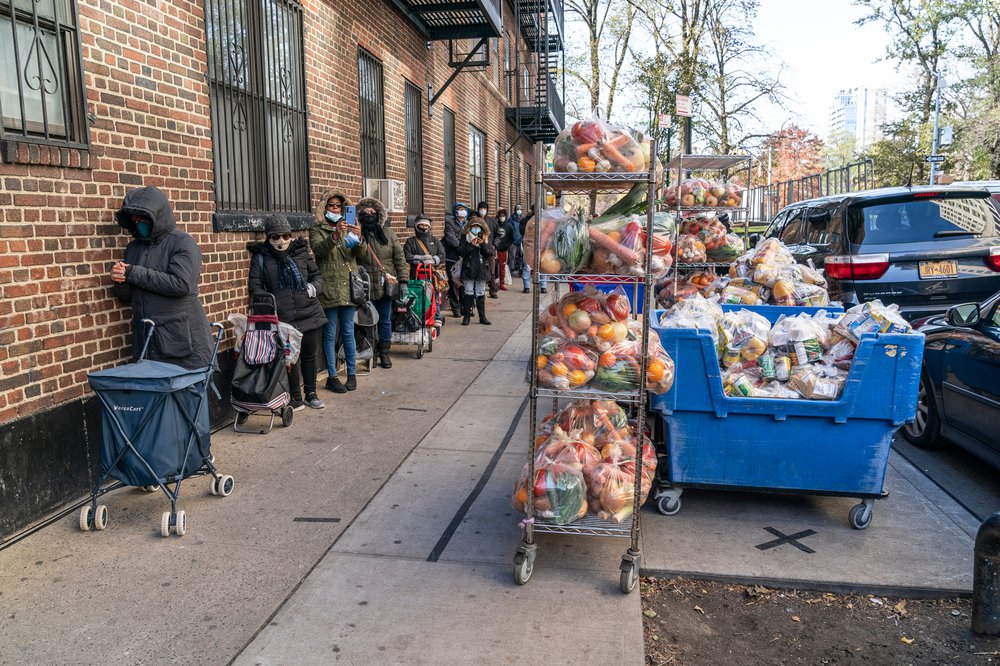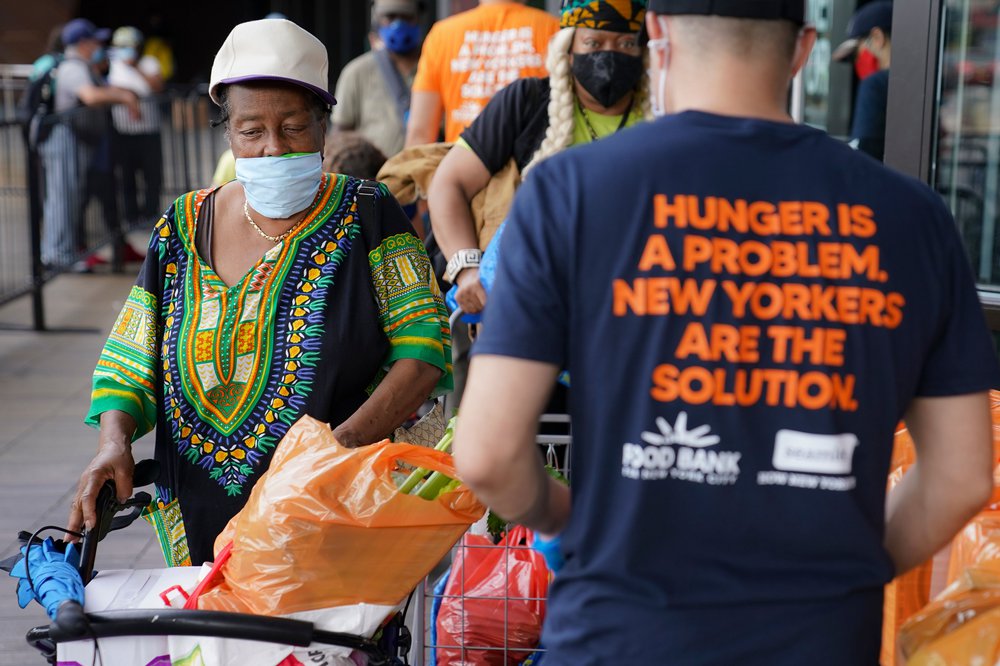Widespread Hunger Persists Even As New York’s Economy Recovers
June 8, 2021, 3:25 p.m.
While some families have used their stimulus checks to cover costs, others are racking up credit card debt and borrowing money from friends.

Last spring, the economic engine of New York City slowed to a near halt and almost immediately, the lines outside food pantries and soup kitchens began to grow. Some 65% more city residents turned to these emergency food resources in 2020 than in 2019. Photos of people waiting on the modern-day equivalent of Depression-era breadlines were among the defining images of COVID-19’s first wave. Many responded by donating money or food or volunteering with organizations addressing hunger.
As vaccination rates rise and the city approaches a full reopening, hunger may no longer be top of mind for many New Yorkers. But those working in food banks and pantries say demand is still much higher than it was before the pandemic, especially among groups that were already more vulnerable.
“When it comes to the lines, we're really working with our partners to manage those through different technology efficiencies,” said Zanita Tisdale, senior director of member engagement at Food Bank for New York City. “But the volume of families and individuals that are coming has really remained much the same as we saw during the pandemic.”
A new report from the New York State Health Foundation backs Tisdale’s observation. About 12% of adults statewide aren’t getting enough to eat from week to week. That’s down slightly from a mid-pandemic peak of approximately 14%. The survey involved about 1,500 adults and is part of the COVID-19 Household Pulse Survey, a federal initiative designed by the U.S. Census Bureau.
Black and Hispanic New Yorkers continue to go hungry at dramatically higher rates than their white neighbors.
But Black and Hispanic New Yorkers continue to go hungry at dramatically higher rates than their white neighbors. While some families have used their stimulus checks to cover costs, others are racking up credit card debt and borrowing money from friends.
In March 2021, the most recent month covered in the report, more than 20% of Black respondents and 29% of Hispanic New Yorkers reported that they were recently facing food insecurity, compared with just 5% of white survey takers.
These disparities existed before the pandemic, driven by income inequality and by benefits programs that exclude many immigrants, says Nicholas Freudenberg, director of the CUNY Urban Food Policy Institute.
“The pandemic has illuminated the inequitable characteristics of the food system and provided an opportunity to address some of those,” Freudenberg said.
Demand At Pantries And Soup Kitchens Remains High
Food Bank for NYC distributed about 140 million pounds of food to pantries and kitchens across the city between April 2020 and March 2021, a 63% increase over the previous year. Some 40% of the 800 nonprofit partners Food Bank serves initially closed their doors during the pandemic’s first wave to avoid risking the safety of staff and volunteers, many of whom were seniors. But most of these food services have started operating again and continue to require bigger shipments than they did pre-pandemic, Tisdale says.
City Harvest, a Manhattan-based food rescue organization that delivers to some 400 pantries and kitchens across the boroughs, has seen a similar trend.
“Demand, obviously, just went through the roof when the pandemic hit, and what we're seeing is that it's plateaued,” said Seth Cowan, agency operations manager for City Harvest. “We're scheduling regular tractor-trailer loads of food to places that would never have been able to handle that before. They would have balked or laughed at us.”
Cowan says he anticipates that “the tail of the recovery in the work that we do will be long” and that heightened demand will continue into 2022.

At Henry Street Settlement, a Lower East Side nonprofit that ramped up its emergency food programs last year, demand has dipped only about 20% to 30% from the height of the pandemic, says David Garza, president and CEO of the organization.
Henry Street recently surveyed those receiving food through its pantry and delivery programs and found that 45% had annual household incomes of less than $10,000, and 70% had incomes of less than $35,000. Yet, only 35% of recipients were enrolled in the federal Supplemental Nutrition Assistance Program, or SNAP (formerly known as food stamps).
Garza said the next step is improving public knowledge and enrollment for those eligible for the program. “It’s a more comprehensive, effective resource for people who are food insecure,” Garza said. “It gives them agency in what they access and where they shop.”
Spreading The Word About SNAP
Families with children are disproportionately affected. In March, more than 20% of New Yorkers living with children said those kids didn’t have enough to eat, according to the NYS Health Foundation report. That’s more than in almost any other month since the Census Bureau began collecting pandemic data on this group in June 2020. Children in New York City received 96 million fewer meals from schools during the pandemic, despite an adapted grab-and-go program hosted at public school buildings, Chalkbeat reported last week.
NYS Health Foundation recorded that close to half of New Yorkers facing food scarcity used their stimulus checks to help pay for the things they needed, and just under one-third used their unemployment benefits. A majority—52%—sought money from friends and family to make ends meet, and a third took out loans or used credit cards.
“These aren't very stable funding sources, and they have the potential to make things even worse,” said Mark Zezza, director of policy and research at the NYS Health Foundation.
Meanwhile, less than one of every five hungry New Yorkers reported using SNAP, suggesting that the program isn’t reaching everyone who needs it. Freudenberg and Zezza say applying and recertifying membership in SNAP and other benefit programs can be difficult.
The process is time-consuming, and some people with low incomes are ineligible for SNAP because of their immigration status. And even when people are enrolled, they may require supplemental food. Those who work in the sector say there is often a lull at pantries and kitchens during the beginning of the month and more visitors near the end of the month when SNAP benefits run out. But many who are eligible aren’t enrolled at all, says Joel Berg, CEO of Hunger Free America, a national organization based in the Financial District.
Mayor Bill de Blasio’s executive budget included $32 million to expand emergency food distribution programs in fiscal year 2022. But Berg says it’s important to carve out funds specifically for benefits enrollment and outreach. Every dollar spent on SNAP outreach generates $30 of federal SNAP benefits, estimates Berg, whose organization has an office in the Bronx dedicated to enrolling people in the program.
Berg is also touring the country advocating for further expansion of SNAP. Congress boosted the maximum amount people can receive through the program by 15% during the pandemic, but that increase is set to expire at the end of September.
Freudenberg urged city and state officials to continue spreading the word about these programs, coordinate efforts across different locations and make it easier to sign up and stay enrolled. He also urged elected leaders to make changes now so that they’re prepared to assist hungry New Yorkers during future crises.
“We really need to look at those administrative hurdles and look for ways to cut through them,” he said.